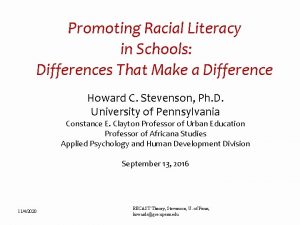Developing Racial Literacy USING READERS THEATER IN TEACHER

- Slides: 1

Developing Racial Literacy USING READERS’ THEATER IN TEACHER EDUCATION TO CRITICALLY ADDRESS RACE & RACISM Christina Berchini, Ph. D | English Department | Wisconsin Teaching Fellows & Scholars Spring Conference, 2017 PROJECT OVERVIEW This study illustrates how Readers Theater, when used as a pedagogical tool in the teacher education classroom, encourages pre‐service teachers to engage with productive opportunities for self‐ reflection and discussion about how race, racism, and whiteness interact with curriculum, pedagogy, and students’ schooling experiences. Specifically, this presentation uses qualitative case study methods—including vignettes, observations, and interview data—to show pre‐service teachers critically examined not only their pedagogical beliefs, but also specific examples of how school structures and expectations for teaching help to shape teachers’ classroom practices and relationships with students. This research suggests that Readers Theater can be used as a tool with which to develop critically reflective pre‐service English teachers; the strategies and discussions presented here offer opportunities to identify and understand how race, whiteness, and racism interact with curriculum, pedagogy, and students’ relationships with literature. WHY READERS’ THEATER? • The readers theater experience stimulated participants to thoughtfully reexamine personal experiences and reconsider past actions and interpersonal communication…. This opportunity to reflect promotes personal awareness and insight. (Pardue, 2004, p. 61) SAMPLE READERS’ THEATER SCRIPT/ANALYSIS DEFINING RACIAL LITERACY • Racial literacy is an understanding of the powerful and complex ways in which race influences the social, economic, political, and educational experiences of individuals and groups. • Racial literacy involves a discernment of the structural, political, and economic circumstances or antecedents that underlie racism and disadvantage. • For a racially literate person, race functions as a tool of diagnosis, feedback, and assessment of conditions within society and people’s lived experiences. • Relationships between race and power, and the psychological, interpersonal, and structural dimensions of race are emphasized. • While acknowledging individual agency, a racial literacy perspective admits the institutional and environmental constraints on individuals’ actions. (Skerrett, 2011, p. 314) RESEARCH QUESTIONS Place your image subtext here Credit: http: //trevorcairney. blogspot. com/2012/06/readers‐theatre‐ideas‐for‐improving. html • The power of RT can be seen in its ability to engage learners in constructing their own language growth, reflecting meaning in the fullest sense of personal and cultural relevance, developing students’ individual language abilities, and supporting self‐initiated activity. (Liu, 2000, p. 359) Place your image subtext here 1) How do participants make sense of their racial identity development in a course that examines race and racism? 2) In what ways can participants’ concept development be attributed to class activities in which Readers’ Theater pedagogy is employed? CONTEXT/METHODS Participants were UWEC students enrolled in an English course focused on race and racial representation. This qualitative study explores how students made sense of their lived experiences (e. g. in school and the broader community) and racial identity development in a course that uses literature and other texts to examine whiteness, race, and racism. In this course, the instructor and students explored whiteness, race, and racism in text, classroom discourse (using extant data in published studies), schools (as portrayed in literature and text), policy, curriculum (k‐ 12 curriculum), and also the lived experiences they bring to the classroom setting. This project focuses on the use of Readers’ Theater as a pedagogical method to critically address race and racism. DATA COLLECTED • Student‐produced artifacts; • Classroom discussion of Readers’ Theater scripts; • Semi‐structured interviews; • Focus‐group discussions. DISCUSSION CRITICAL REFLECTION K: What I would do differently is – show more examples – the kids don’t really believe it. Give them articles that show evidence. I do really like that he makes it…it’s not a very hateful discussion. It’s more meaningful. ” • Readers’ Theater encourages teacher education students to examine pedagogy from a far—to witness the teaching of difficult concepts and topics at a safe distance, in order to consider the affordances and challenges in individual classroom episodes. EMPATHY C: I think what stood out to me was the kids’ anger. Just the fact that he would say things “oh because you’re white” – and they got angry. But I do understand where they’re coming from, because I did go through that. And I think it shows, because Mr. Kurt did say, in one of the lines, you learn racism because you grow up with it. And you catch on, and you hear your parents and people around you talk about that stuff, and you catch on. • Readers’ Theater instills a sense of empathy – not just for the teacher teaching challenging content, but for students consuming it. HISTORICAL CONTEXT AND SITUATED-NESS OF CULTURAL T: RTIFACTS “Every other month is white history month” – do the students really know what he’s getting at? You can say that, but maybe the students don’t understand A why every other month is white history month. Or sometimes, why is it that Band‐Aids are racist? So stating that clearly. • Readers’ Theater can highlight spaces in which teaching challenging content (e. g. racism and racialized cultural artifacts) requires historical context in order to create a more meaningful teaching and learning experience. I. e. , an exploration of where/how critical analyses of context and power are needed. We thank the Office of Research and Sponsored Programs for supporting this research, and Learning & Technology Services for printing this poster.

